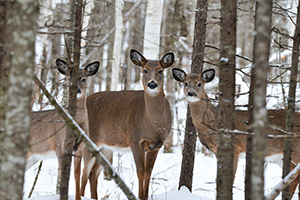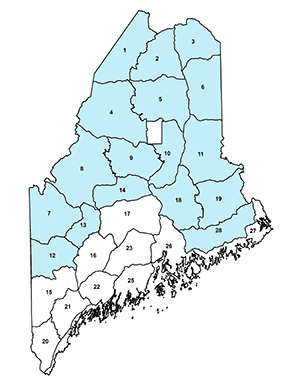Home → Fish & Wildlife → Wildlife → Species Information → Mammals → White-tailed Deer → Maine Deer Spy → Northern Maine Wintering Deer Survey
Northern Maine Wintering Deer Survey

Background

Deer in northern Maine exist near the northern extent of their range and are often subjected to severe winter conditions, which limit population growth. To persist through these severe winters, deer employ different strategies. Traditionally, deer in northern Maine used deer wintering areas consisting of mature softwoods cover with good canopy closure to protect them from the elements, and in recent decades, many deer have taken to wintering in or near towns where they are safer from predators, have access to artificial feed provided by humans, and can use snowmobile trails and plowed trails to get around.
Deer populations in northern Maine have been cyclical over the years with the ups and downs corresponding to variable winter conditions. To try and smooth out these ups and downs, Maine Department of Inland Fisheries and Wildlife (MDIFW) has worked with landowners to protect deer wintering habitat through cooperative agreements, and more recently, MDIFW has started to purchase land to be owned and managed by the State for deer wintering habitat.
To assess whether community science reports of wintering deer may inform deer wintering area protection efforts, a community science project has been added to Maine Deer Spy portal called the Northern Maine Wintering Deer Survey. This project will collect observations from winter recreationists and workers in the field during the winter to try and identify areas where deer are naturally wintering. Identification of such areas may inform conservation efforts.
For this project, we are interested in receiving observations of deer in natural wintering habitat and only from the area of the state colored in blue on the map to the right (Wildlife Management Districts (WMDs) 1-14, 18, 19, 28). Natural wintering habitat consists of softwoods-dominated stands with primarily trees greater than 35 feet tall and canopy closure of 70% or more. You do not need to submit reports of deer in or near towns.
How to Participate
Participating is easy! When you observe any wintering white-tailed deer in northern Maine between January 1 and March 31, please click the link below and submit your observations. You do not need to submit reports of deer in or near towns.
- Location
- Date and time
- Number of deer seen (dead or alive)
- Whether you have seen deer at this location before
Submit Wintering Deer Survey Data
Frequently Asked Questions
Why are you only collecting observations for northern Maine?
We are interested in locating groups of wintering deer throughout northern Maine to better understand where deer are wintering and potentially inform land acquisition, conservation, and management efforts.
Should I report dead deer that I observe?
Yes. Travelers through Maine's northern forests in winter (snowmobilers, ice fishermen, etc.) may encounter dead deer, and we are interested in these observations as well. Just the same as live deer, they let us know deer were using the area during the winter.
Do I need an internet connection to submit my observations?
You will need an internet connection to submit your observation. If you do not have internet but are able to record field coordinates for your observation (latitude, longitude), you can submit your record when you next have internet by using the coordinates. If you are able to find the location on a map, you may choose to drop a point on a map within the survey to mark the location of your observation.
Why don't you need observations of deer around town?
We are most interested in identifying populations of wintering deer in natural habitat that we are not already aware of and that may help us identify important areas for wintering habitat conservation and management. Many deer winter in or around towns in northern Maine, but these are not prime areas for MDIFW land acquisition and management efforts, and we are often already aware of deer wintering in or near towns.
Progress and Future
Data from this project are compiled at the end of each observation season and will be summarized each year in the MDIFW Research and Management Report.